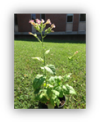Current Research Interests
Organelle Gene Expression
Members of my lab and collaborators recently
published a survey of all the transcripts produced by the tobacco
mitochondrial genome (Grimes
et al 2014). We
initially asked the questions, “Why does the tobacco mitochondrial
genome have so many uncharacterized open reading frames?
And
Are any of them transcribed
and translated?”
We learned that some of them are transcribed
and some may even be translated into protein.
Another transcriptome and RNA processing study is nearly
completed for the dinoflagellate
Karenia brevis, which
is an environmentally important alga that causes
red tide.
This project was begun with the simple
question, “Can we identify the chloroplast genes of the non-model
alga, K. brevis using the
sequenced transcriptome?” ; “Can we determine the genome morphology
from the transcriptome?” ; and “Is it possible to infer processing
events from the transcriptome?”
So far, more than 50
K. brevis chloroplast
transcripts have been identified and several interesting processing
events have been characterized.
Plant Tissue Culture
I have used culture techniques for embryo
rescue, organogenesis, and embryogenesis, as needed, for the
completion of experiments over the last 20+ years.
I have also taught tissue culture as part of a course in
plant biotechnology.
Recently, a collaboration with the
Tennessee Center for
Botanical Medicine Research inspired the culture of plants used
in traditional
herbology, including
American
ginseng (Panax
quinquefolius). My
lab is currently attempting to answer the question, “What is the
best way to cultivate ginseng on a commercial scale using
micropropagation techniques?”






